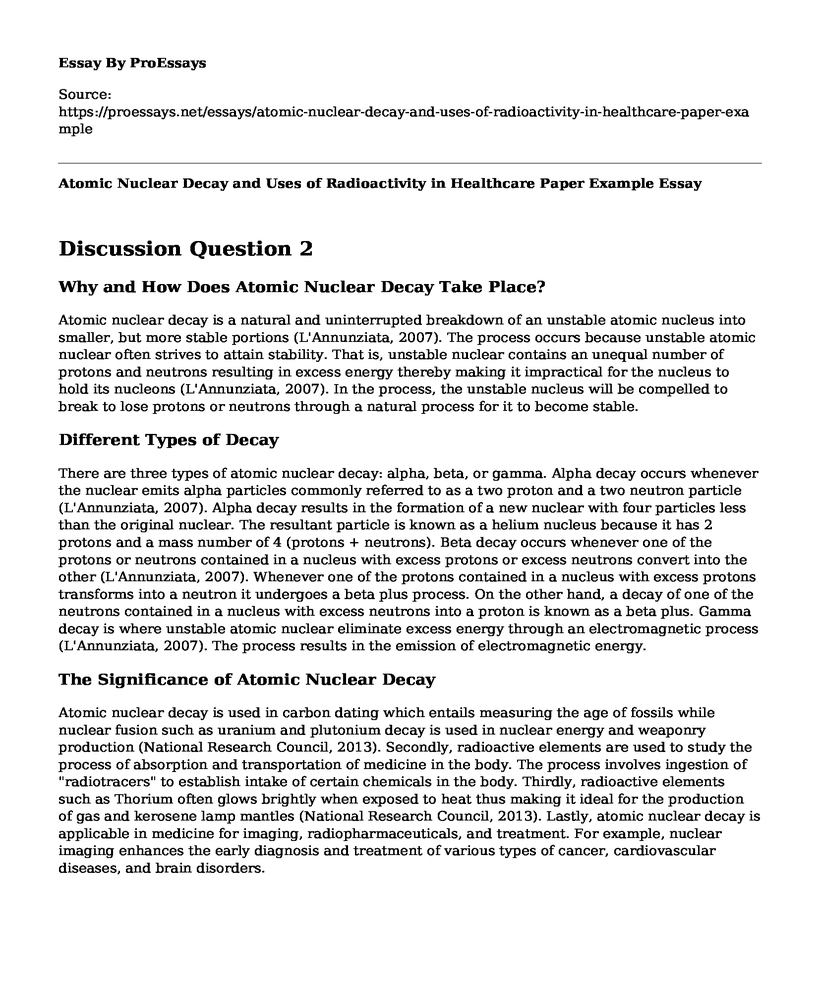Discussion Question 2
Why and How Does Atomic Nuclear Decay Take Place?
Atomic nuclear decay is a natural and uninterrupted breakdown of an unstable atomic nucleus into smaller, but more stable portions (L'Annunziata, 2007). The process occurs because unstable atomic nuclear often strives to attain stability. That is, unstable nuclear contains an unequal number of protons and neutrons resulting in excess energy thereby making it impractical for the nucleus to hold its nucleons (L'Annunziata, 2007). In the process, the unstable nucleus will be compelled to break to lose protons or neutrons through a natural process for it to become stable.
Different Types of Decay
There are three types of atomic nuclear decay: alpha, beta, or gamma. Alpha decay occurs whenever the nuclear emits alpha particles commonly referred to as a two proton and a two neutron particle (L'Annunziata, 2007). Alpha decay results in the formation of a new nuclear with four particles less than the original nuclear. The resultant particle is known as a helium nucleus because it has 2 protons and a mass number of 4 (protons + neutrons). Beta decay occurs whenever one of the protons or neutrons contained in a nucleus with excess protons or excess neutrons convert into the other (L'Annunziata, 2007). Whenever one of the protons contained in a nucleus with excess protons transforms into a neutron it undergoes a beta plus process. On the other hand, a decay of one of the neutrons contained in a nucleus with excess neutrons into a proton is known as a beta plus. Gamma decay is where unstable atomic nuclear eliminate excess energy through an electromagnetic process (L'Annunziata, 2007). The process results in the emission of electromagnetic energy.
The Significance of Atomic Nuclear Decay
Atomic nuclear decay is used in carbon dating which entails measuring the age of fossils while nuclear fusion such as uranium and plutonium decay is used in nuclear energy and weaponry production (National Research Council, 2013). Secondly, radioactive elements are used to study the process of absorption and transportation of medicine in the body. The process involves ingestion of "radiotracers" to establish intake of certain chemicals in the body. Thirdly, radioactive elements such as Thorium often glows brightly when exposed to heat thus making it ideal for the production of gas and kerosene lamp mantles (National Research Council, 2013). Lastly, atomic nuclear decay is applicable in medicine for imaging, radiopharmaceuticals, and treatment. For example, nuclear imaging enhances the early diagnosis and treatment of various types of cancer, cardiovascular diseases, and brain disorders.
Precaution and Safety Measures
The society should be careful when dealing with atomic nuclear decay because of the dangers associated with the process. Firstly, gamma decay produces electromagnetic radiation (energy) which has the capacity to travel a long distance and penetrate deeper thereby making the radiation harmful to the human society (National Research Council, 2013). Secondly, radiation is associated with cancer in humans thus need to be handled with care.
Discussion Question 2
Uses of Radioactivity in Healthcare
Radioactivity is useful in healthcare where physicians employ the process to diagnose, monitor and treat varied diseases. The first application of radioactivity in healthcare is diagnostic x-rays where radiation is passed through the skin to provide the actual outline of bones and other body structures (National Research Council, 2013). X-ray photographic films are used by physicians to spot defects on bones and dental system for effective treatment. Secondly, x-rays and radiations are continuously being used by physicians to administer cancer therapy. The radiations are administered to kill cancerous cells and reduce pain and tumor size among patients (National Research Council, 2013). For example, iodine radiation is administered as a treatment for patients with thyroid cancer. Thirdly, x-ray radiation produces crucial images of body organs whenever the x-ray machines are connected with computers through computerized axial tomography (CAT) and computed tomography (CT) (National Research Council, 2013). These images are used by physicians to identify, understand, and administer appropriate treatment on organs or tissue.
Future Trends in Healthcare With Respect To the Use of Radioactivity
Ideally, the future trends of radioactivity application in the healthcare are hard to predict. However, following the historical trends, it is probable that there will be more considerable and crucial contribution of radioactivity in healthcare (National Research Council, 2013). Most advances in radiology and nuclear medicine will be associated with progress in radioactivity. For example, the future of personalized medicine will require advanced radioactive tools which will promote the development of patient-specific diagnostic tools for individualized treatment (L'Annunziata, 2007). In addition, advancement in genetically engineered antibodies is likely to be paired with radioactive nuclides to enhance understanding of the primary cause of diseases (National Research Council, 2013). Pairing radioactive nuclides with antibodies will allow physicians to extra information about how antibodies function to enable effective treatment of diseases.
References
L'Annunziata, F. M. (2007). Radioactivity: Introduction and history. Oxford, Paris: Elsevier.
National Research Council. (2013). Societal applications and benefits. In National Research Council (Ed.), Nuclear physics: Exploring the heart of matter (pp. 154-180). Washington, D.C.: National Academies Press.
Cite this page
Atomic Nuclear Decay and Uses of Radioactivity in Healthcare Paper Example. (2022, Oct 03). Retrieved from https://proessays.net/essays/atomic-nuclear-decay-and-uses-of-radioactivity-in-healthcare-paper-example
If you are the original author of this essay and no longer wish to have it published on the ProEssays website, please click below to request its removal:
- Geology Survey Plan - Course Work Sample
- Essay on Christian View of Euthanasia
- Efficacy of External Cold and Vibration of the BUZZY System on Pain Reduction During IV Insertion
- Rotator Cuff Injuries Paper Example
- Radon: A Silent Killer With Life-Threatening Effects - Essay Sample
- Essay Sample on Pediatric Hospitalization: Challenges & Expenses of Rare Diseases
- Paper Example on PMHNP Practicum: Integrating Theory with Professional Practice







